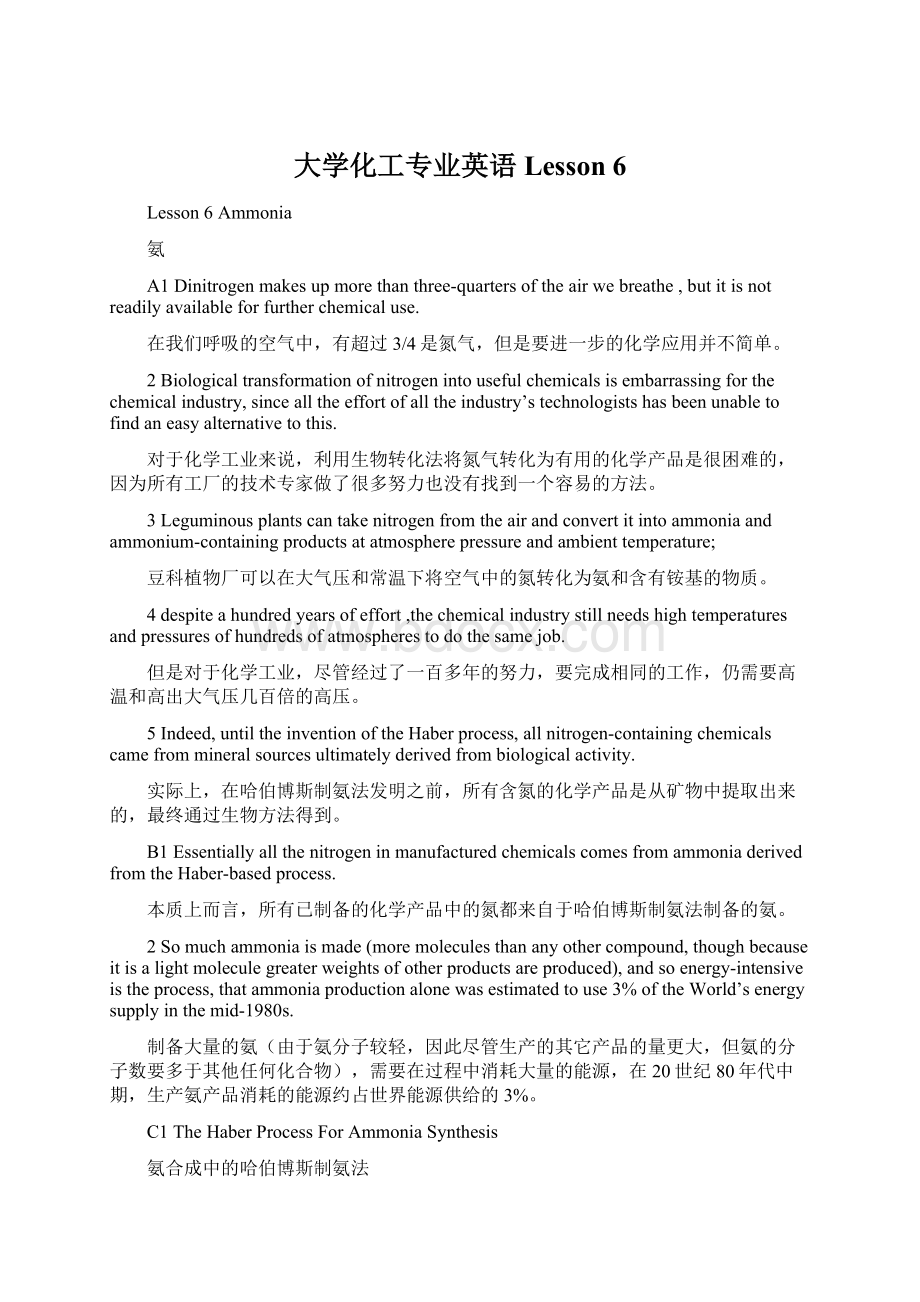大学化工专业英语Lesson 6.docx
《大学化工专业英语Lesson 6.docx》由会员分享,可在线阅读,更多相关《大学化工专业英语Lesson 6.docx(7页珍藏版)》请在冰豆网上搜索。

大学化工专业英语Lesson6
Lesson6Ammonia
氨
A1Dinitrogenmakesupmorethanthree-quartersoftheairwebreathe,butitisnotreadilyavailableforfurtherchemicaluse.
在我们呼吸的空气中,有超过3/4是氮气,但是要进一步的化学应用并不简单。
2Biologicaltransformationofnitrogenintousefulchemicalsisembarrassingforthechemicalindustry,sincealltheeffortofalltheindustry’stechnologistshasbeenunabletofindaneasyalternativetothis.
对于化学工业来说,利用生物转化法将氮气转化为有用的化学产品是很困难的,因为所有工厂的技术专家做了很多努力也没有找到一个容易的方法。
3Leguminousplantscantakenitrogenfromtheairandconvertitintoammoniaandammonium-containingproductsatatmospherepressureandambienttemperature;
豆科植物厂可以在大气压和常温下将空气中的氮转化为氨和含有铵基的物质。
4despiteahundredyearsofeffort,thechemicalindustrystillneedshightemperaturesandpressuresofhundredsofatmospherestodothesamejob.
但是对于化学工业,尽管经过了一百多年的努力,要完成相同的工作,仍需要高温和高出大气压几百倍的高压。
5Indeed,untiltheinventionoftheHaberprocess,allnitrogen-containingchemicalscamefrommineralsourcesultimatelyderivedfrombiologicalactivity.
实际上,在哈伯博斯制氨法发明之前,所有含氮的化学产品是从矿物中提取出来的,最终通过生物方法得到。
B1EssentiallyallthenitrogeninmanufacturedchemicalscomesfromammoniaderivedfromtheHaber-basedprocess.
本质上而言,所有已制备的化学产品中的氮都来自于哈伯博斯制氨法制备的氨。
2Somuchammoniaismade(moremoleculesthananyothercompound,thoughbecauseitisalightmoleculegreaterweightsofotherproductsareproduced),andsoenergy-intensiveistheprocess,thatammoniaproductionalonewasestimatedtouse3%oftheWorld’senergysupplyinthemid-1980s.
制备大量的氨(由于氨分子较轻,因此尽管生产的其它产品的量更大,但氨的分子数要多于其他任何化合物),需要在过程中消耗大量的能源,在20世纪80年代中期,生产氨产品消耗的能源约占世界能源供给的3%。
C1TheHaberProcessForAmmoniaSynthesis
氨合成中的哈伯博斯制氨法
Introduction.Allmethodsformakingammoniaarebasicallyfine-tunedversionsoftheprocessdevelopedbyHaber,NernstandBoschinGermanyjustbeforetheFirstWar.
介绍。
哈伯、能斯特和波希于一战前在德国开发出了哈伯工艺,现在所有的合成氨方法基本工艺都是以该法为基础、再稍微加以改变的。
N2+3H2=2NH3
D1Inprinciplethereactionbetweenhydrogenandnitrogeniseasy;itisexothermicandtheequilibriumliestotherightatlowtemperatures.
从理论上来讲,氢气和氮气的反应很简单,反应是放热的,在低温时,平衡向右移动。
2Unfortunately,naturehasbestoweddinitrogenwithaninconvenientlystrongtriplebond,enablingthemoleculetothumbitsnoseatthermodynamics.
不幸的是,自然赠与了氮分子强烈的三键结合,使该分子不易受热力学因素的影响。
3Inscientifictermsthemoleculeiskineticallyinert,andratherseverereactionconditionsarenecessarytogetreactionstoproceedatarespectablerate.
用科学术语来说,该分子是动力学惰性的,因此,要使该反应以一定的速度进行,需要相当苛刻的反应条件。
4Amajorsourceof“fixed”(meaning,paradoxically,“usefullyreactive”)nitrogeninnatureislightning,wheretheintenseheatissufficienttocreatenitrogenoxidesfromnitrogenandoxygen.
自然界中“固定”(与“有效的活动性”相反)氮的一个主要的来源是闪电,巨大的热量使氮气和氧气生成氮的氧化物。
E1Togetarespectableyieldofammoniainachemicalplantweneedtouseacatalyst.
在化工厂里,为了得到氨的可观的产量,我们需要使用催化剂。
2WhatHaberdiscovered-anditwonhimaNobleprize-wasthatsomeironcompoundswereacceptablecatalysts.
哈伯发现一些铁的化合物可以做催化剂,这使他获得了诺贝尔奖。
3Evenwithsuchcatalystsextremepressures(upto600atmospheresinearlyprocesses)andtemperatures(perhaps400℃)arenecessary.
但是,即使有这些催化剂,这个反应仍然需要很高的压力(在早期的工艺中高达600个大气压)和高温(大约400℃)。
F1Pressuredrivestheequilibriumforward,asfourmoleculesofgasarebeingtransformedintotwo.
由于四个气体分子转化为两个气体分子,所以增加压力使平衡向右移动。
2Highertemperatures,however,drivetheequilibriumthewrongway,thoughtheydomakethereactionfaster,chosenconditionsmustbeacompromisethatgivesanacceptableconversionatareasonablespeed.
虽然高温可以加快反应速度,但它使平衡向反向移动,因此,所选的条件必须要适当,从而使反应在合理的速率下有令人满意的转化率。
3Theprecisechoicewilldependonothereconomicfactorsandthedetailsofthecatalyst.
反应条件的准确选择将取决于其他的经济因素和催化剂的具体情况。
4Modernplantshavetendedtooperateatlowerpressuresandhighertemperatures(recyclingunconvertedmaterial)thanthenearer-idealearlyplants,sincethecapitalandenergycostshavebecomemoresignificant.
现代工厂已倾向于在更低压和更高温下操作(回收没有转化的材料),因为投资费用和能量费用已变得更为重要。
G1Biologicalfixationalsousesacatalystwhichcontainsmolybdenum(orvanadium)andironembeddedinaverylargeprotein,thedetailedstructureofwhicheludedchemistsuntillate1992.
氮的生物固定也要使用催化剂,催化剂是将钼(或这钒)和铁嵌入巨大的蛋白质中,细微的结构困扰着化学家直到1992后期。
2Howitworksisstillnotunderstoodindetail.
它是如何起作用的直到现在也没有完全弄明白。
H1RawMaterials.Theprocessrequiresseveralinputs:
energy,nitrogenandhydrogen.
原料。
过程中需要的原料有:
能量、氮气和氢气。
2Nitrogeniseasytoextractfromair,buthydrogenisanotherproblem.
氮气很容易从空气中提取,但氢气是一个问题。
3Originallyitwasderivedfromcoalviacokewhichcanbeusedasarawmaterial(basicallyasourceofcarbon)insteamreforming,wheresteamisreactedwithcarbontogivehydrogen,carbonmonoxideandcarbondioxide.
最初,氢气是从煤的焦化中得到的,将焦炭作为一种原材料(碳的一种基本的来源)在水蒸汽中转化,水蒸气和碳反应生成氢气、一氧化碳和二氧化碳。
4Nownaturalgas(mainlymethane)isusedinstead,thoughotherhydrocarbonsfromoilcanalsobeused.
现在由天然气代替(